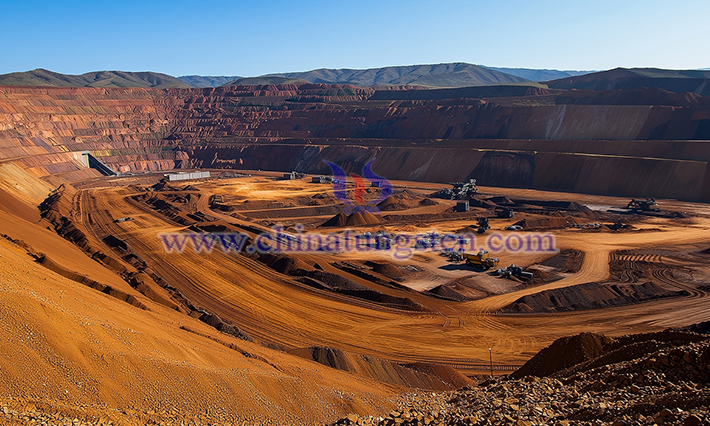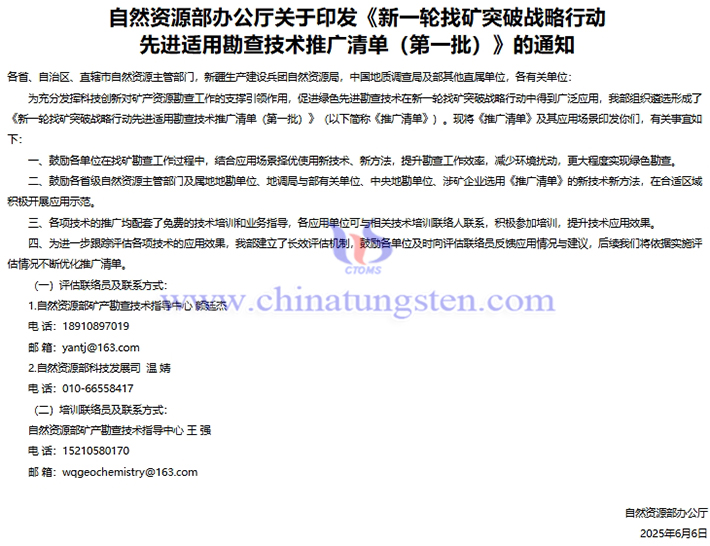Four Advanced and Applicable Exploration Technologies Related to Molybdenum
- Details
- Category: Tungsten's News
- Published on Thursday, 19 June 2025 16:40
On June 6, 2025, the General Office of the Ministry of Natural Resources issued the "List of Advanced and Applicable Exploration Technologies for the Promotion of a New Round of Strategic Actions for Mineral Exploration Breakthroughs (First Batch)", of which there are 4 technologies related to molybdenum:
1. Rhenium-Osmium Isotope Dating Technology-National Geological Experimental Testing Center
Applicant: National Geological Experimental Testing Center
Technical Content: Rhenium-osmium isotope dating technology obtains isotopic age by measuring the content and isotope ratio of rhenium and osmium in geological samples. Rhenium and osmium have sulfur-loving, copper-loving and iron-loving characteristics, and sulfides can be used to directly determine the age of metal deposits. Rhenium and osmium also have the property of affinity for organic matter, and can determine the age of organic-rich geological samples such as asphalt, crude oil, graphite, black shale, limestone, etc., which is an effective means to determine the hydrocarbon generation and accumulation age of oil and gas reservoirs, and the sedimentary and metamorphic age of strata.
Technical Features: ultra-low process blank, rhenium and osmium full process blank is less than 3 pg and 0.1 pg respectively; ultra-high sensitivity, can perform isotopic dating on samples with rhenium>20 pg/g and osmium>1 pg/g; high precision, the internal accuracy of instrument measurement is better than 0.05%, and the accuracy of model age determination reaches about 0.5%. Minerals for dating deposits include sulfides such as molybdenite, chalcopyrite, pyrite, arsenopyrite, pyrrhotite, and oxides such as magnetite. Objects for dating oil and gas accumulation include crude oil, asphalt, etc. Objects for sedimentary and metamorphic age determination include black shale, organic-rich limestone, graphite, etc. The objects of material source tracer determination include igneous rocks, chromite, magmatic sulfides, etc.
Application Cases: Case 1: The age determination of more than 300 mineral deposits at home and abroad has been completed, providing 85% of the domestic rhenium-osmium dating data. It provides important theoretical basis for the study of mineralization laws and geodynamic background of mineralization in metallogenic belts such as Gangdise, Sanjiang, Bannu, the middle and lower reaches of the Yangtze River, Nanling, Central Asian orogenic belt, and East Tianshan. Case 2: The rhenium-osmium isochron age of the 23rd to 24th layers of limestone in the Permian-Triassic boundary section of Changxing, Zhejiang Province was determined to be 251.8±4.7 Ma, which is consistent with the uranium-lead age of the 25th layer of zircon, indicating that the rhenium-osmium isotope dating technology can directly determine the sedimentary age of the limestone strata.

2. Field Testing Technology for Solid Minerals
Applicant: National Geological Experimental Testing Center
Technical Content: The laboratory is moved forward to the front line of prospecting, shortening the analysis cycle to 24-48 hours, realizing the testing of samples as they are collected, and supporting exploration decisions in real time, which can change the traditional prospecting model and improve the speed of resource exploration. The technical capabilities formed by the project are evaluated through the field applicability of various technologies to achieve economic, practical and effective results. Strengthen and improve the technical system of field analysis equipment and standard methods, and gradually form and improve the field rapid investigation and exploration technology system composed of "digital mapping-remote sensing-geophysical exploration-chemical exploration-drilling (shallow drilling, drilling instead of slots, reverse circulation drilling, etc.)-analysis and testing-GIS big data", and further build a modern ground detection technology system coordinated by sky-air-ground (land and sea).
Technical Features: According to the characteristics of the combination of mineral elements, form an analytical instrument configuration plan, combine the Internet of Things control system and the mobile laboratory management system, and form a modular and intelligent new generation of field rapid analysis and testing platform. The platform has coarse and medium crushers, disc mills, microwave digesters, X-ray fluorescence spectrometers, direct reading spectrometers, lithium-potassium analyzers, gold detectors and other instruments and equipment. It is suitable for field testing and analysis of 20 elements of lithium, beryllium, silver, boron, potassium, gold, copper, lead, zinc, iron, manganese, cobalt, nickel, arsenic, bismuth, tungsten, tin, molybdenum, chromium, and antimony in whole rocks, soils, and sediments in remote areas such as forests, grasslands, plateaus, and Gobi, as well as a variety of important mineral mineralization and associated elements such as rare earths, uranium mines, and copper mines. It adopts green and environmentally friendly technology, does not use acids and alkalis, does not produce harmful waste, and does not cause damage and disturbance to the environment.
Application Cases: Case 1: Cooperating with the Shenyang Center, supporting the verification of copper mine anomalies in the Greater Khingan Range, providing a basis for optimizing the drilling layout plan, reducing a total of 16 drilling holes, shortening the working time by 68%, and delineating the intrusive rock-volcanic rock contact zone that is conducive to mineralization. Case 2: Cooperating with Xi'an Center, we supported geochemical anomaly verification in Altai, Xinjiang, analyzed 1,585 samples within 20 days, and obtained results within 1 hour. We accurately delineated multi-element geochemical anomalies and brought forward the 2024 exploration trench design to the second half of 2023.
3. Strategic Mineral Multi-Element Analysis and Testing Technology
Applicant: National Geological Experimental Testing Center
Technical Content: Strategic mineral multi-element analysis and testing technology is an indispensable key metal element for the development of national strategic emerging industries. It innovatively establishes the simultaneous determination technology of rare, scattered, and rare earth elements in various ores such as tungsten, molybdenum, niobium and tantalum ores, the precise determination technology of heavy rare earth elements in Bayan Obo ores, and the precise determination technology of ion adsorption type rare earth components. The new technical system and research model replaces traditional single element testing methods such as organic reagent extraction-photometric determination, which can greatly improve the efficiency and quality of sample testing, greatly reduce the amount of chemical reagents, and reflect the concept of green development.
Technical Features: The hydrofluoric acid resistant system of inductively coupled plasma spectroscopy can effectively solve the problem that elements such as tungsten, niobium, and tantalum are prone to hydrolysis instability, resulting in low results. According to the different contents of niobium, tantalum, and tungsten in tungsten, niobium, and tantalum ores, different analysis methods are selected to accurately determine the contents of nearly 30 elements in niobium-tantalum ores, especially for high-content tungsten, niobium, and tantalum samples, which are more advantageous and suitable for the analysis and testing of multiple types of ore samples; the dynamic reaction cell method of inductively coupled plasma mass spectrometry (ICP-MS) can effectively solve the problem that inductively coupled plasma mass spectrometry (ICP-MS) cannot directly and accurately determine the heavy rare earth elements that are seriously interfered. This technology has been applied to the testing of batch samples; the establishment of ammonium sulfate solution extraction-inductively coupled plasma mass spectrometry provides a methodological basis for the analysis and testing of ionic phase rare earths in ion adsorption type rare earths.
Application Case: Case 1: The results of accurately determining niobium-tantalum ore using the hydrofluoric acid resistant system analysis method of inductively coupled plasma spectroscopy: Nb2O5 34.77%; Ta2O5 content 30.89%. Case 2: Accurately analyze more than 2,000 pieces of Bayan Obo rare earth ore. Since the light rare earth in Bayan Obo rare earth ore is very high, it seriously interferes with the accurate determination of its heavy rare earth elements. The dynamic reaction pool method of inductively coupled plasma mass spectrometry (ICP-MS) effectively solves the problem that inductively coupled plasma mass spectrometry (ICP-MS) cannot directly and accurately determine heavy rare earth elements.
4. Vehicle-Mounted Arc Photoelectric Direct Reading Spectrometer Detection Technology
Applicant: Hubei Provincial Geological Experiment and Testing Center
Technical Content: Focusing on the country's new round of strategic mineral exploration breakthrough actions, the Hubei Provincial Geological Experiment and Testing Center is committed to solving the problem of lack of rapid and effective detection methods and equipment in the field exploration of strategic mineral resources such as silver, molybdenum, lithium, beryllium, niobium, tantalum, and rare earth in China. The problem, the Hubei Provincial Geological Experiment and Testing Center has developed a vehicle-mounted photoelectric direct reading spectrometer with completely independent intellectual property rights. It has the advantages of low power consumption, high resolution and signal-to-multiple ratio. It can be used for field detection of more than 20 important strategic mineral resources such as lithium, beryllium, boron, niobium, tantalum, and rare earth, providing powerful equipment and technical support for my country's new round of strategic mineral exploration breakthrough actions.
Technical Features: The instrument uses a small, high-power DC arc as the excitation source, with a maximum output voltage of 10,000V, which can effectively excite powder samples. The optical path of the spectroscopic system is 0.65m, equipped with a 3600-line/mm holographic grating, an instrument resolution of 0.02nm, and a high signal-to-background ratio; direct sampling and analysis of solid powders is simple and efficient to operate, and is suitable for geology, metallurgy, agriculture, environment and other industries. It can achieve rapid quantitative detection of more than 20 elements such as Ag, Li, Be, Nb, B, Sn, Pb, etc. in samples such as ores, rocks, soils, and sediments, and the detection range can be from micrograms to percentages; it can be used for indoor analysis and field prospecting, with little disturbance to the environment, and is an efficient and green exploration technology.
Application Cases: Case: Two field demonstration applications were carried out in the Mufushan mining area in Hubei Province, analyzing more than 600 samples. The detection range was 18.2×10-6~29400×10-6 for lithium, 5.21×10-6~500×10-6 for beryllium, 10.5×10-6~4000×10-6 for niobium, and 57×10-6~8000×10-6 for tantalum. The detection speed was less than 5 minutes/item. The field detection results of each element were verified by indoor chemical methods, and the correlations were all greater than 0.99, meeting the needs of fast and accurate field detection, giving full play to the role of preliminary screening, and supporting real-time decision-making at the exploration site.

- Chinatungsten Online: www.chinatungsten.com
- CTIA GROUP LTD: en.ctia.group
- Tungsten News & Price: www.ctia.com.cn
- Molybdenum News & Price: news.molybdenum.com.cn
- Tel.: 86 592 5129696; Email: sales@chinatungsten.com